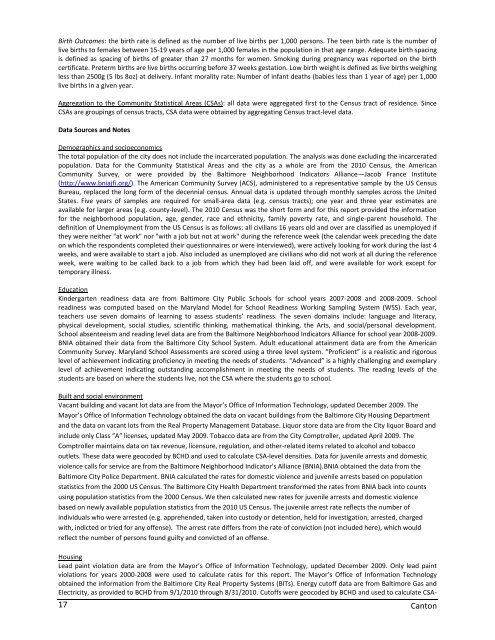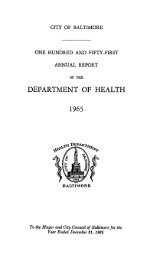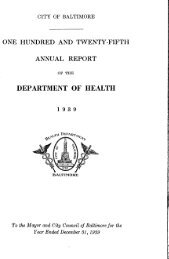Canton - Baltimore City Health Department
Canton - Baltimore City Health Department
Canton - Baltimore City Health Department
You also want an ePaper? Increase the reach of your titles
YUMPU automatically turns print PDFs into web optimized ePapers that Google loves.
Birth Outcomes: the birth rate is defined as the number of live births per 1,000 persons. The teen birth rate is the number of<br />
live births to females between 15-19 years of age per 1,000 females in the population in that age range. Adequate birth spacing<br />
is defined as spacing of births of greater than 27 months for women. Smoking during pregnancy was reported on the birth<br />
certificate. Preterm births are live births occurring before 37 weeks gestation. Low birth weight is defined as live births weighing<br />
less than 2500g (5 lbs 8oz) at delivery. Infant morality rate: Number of infant deaths (babies less than 1 year of age) per 1,000<br />
live births in a given year.<br />
Aggregation to the Community Statistical Areas (CSAs): all data were aggregated first to the Census tract of residence. Since<br />
CSAs are groupings of census tracts, CSA data were obtained by aggregating Census tract-level data.<br />
Data Sources and Notes<br />
Demographics and socioeconomics<br />
The total population of the city does not include the incarcerated population. The analysis was done excluding the incarcerated<br />
population. Data for the Community Statistical Areas and the city as a whole are from the 2010 Census, the American<br />
Community Survey, or were provided by the <strong>Baltimore</strong> Neighborhood Indicators Alliance—Jacob France Institute<br />
(http://www.bniajfi.org/). The American Community Survey (ACS), administered to a representative sample by the US Census<br />
Bureau, replaced the long form of the decennial census. Annual data is updated through monthly samples across the United<br />
States. Five years of samples are required for small-area data (e.g. census tracts); one year and three year estimates are<br />
available for larger areas (e.g. county-level). The 2010 Census was the short form and for this report provided the information<br />
for the neighborhood population, age, gender, race and ethnicity, family poverty rate, and single-parent household. The<br />
definition of Unemployment from the US Census is as follows: all civilians 16 years old and over are classified as unemployed if<br />
they were neither "at work" nor "with a job but not at work" during the reference week (the calendar week preceding the date<br />
on which the respondents completed their questionnaires or were interviewed), were actively looking for work during the last 4<br />
weeks, and were available to start a job. Also included as unemployed are civilians who did not work at all during the reference<br />
week, were waiting to be called back to a job from which they had been laid off, and were available for work except for<br />
temporary illness.<br />
Education<br />
Kindergarten readiness data are from <strong>Baltimore</strong> <strong>City</strong> Public Schools for school years 2007-2008 and 2008-2009. School<br />
readiness was computed based on the Maryland Model for School Readiness Working Sampling System (WSS). Each year,<br />
teachers use seven domains of learning to assess students’ readiness. The seven domains include: language and literacy,<br />
physical development, social studies, scientific thinking, mathematical thinking, the Arts, and social/personal development.<br />
School absenteeism and reading level data are from the <strong>Baltimore</strong> Neighborhood Indicators Alliance for school year 2008-2009.<br />
BNIA obtained their data from the <strong>Baltimore</strong> <strong>City</strong> School System. Adult educational attainment data are from the American<br />
Community Survey. Maryland School Assessments are scored using a three level system. “Proficient” is a realistic and rigorous<br />
level of achievement indicating proficiency in meeting the needs of students. “Advanced” is a highly challenging and exemplary<br />
level of achievement indicating outstanding accomplishment in meeting the needs of students. The reading levels of the<br />
students are based on where the students live, not the CSA where the students go to school.<br />
Built and social environment<br />
Vacant building and vacant lot data are from the Mayor’s Office of Information Technology, updated December 2009. The<br />
Mayor’s Office of Information Technology obtained the data on vacant buildings from the <strong>Baltimore</strong> <strong>City</strong> Housing <strong>Department</strong><br />
and the data on vacant lots from the Real Property Management Database. Liquor store data are from the <strong>City</strong> liquor Board and<br />
include only Class “A” licenses, updated May 2009. Tobacco data are from the <strong>City</strong> Comptroller, updated April 2009. The<br />
Comptroller maintains data on tax revenue, licensure, regulation, and other-related items related to alcohol and tobacco<br />
outlets. These data were geocoded by BCHD and used to calculate CSA-level densities. Data for juvenile arrests and domestic<br />
violence calls for service are from the <strong>Baltimore</strong> Neighborhood Indicator's Alliance (BNIA).BNIA obtained the data from the<br />
<strong>Baltimore</strong> <strong>City</strong> Police <strong>Department</strong>. BNIA calculated the rates for domestic violence and juvenile arrests based on population<br />
statistics from the 2000 US Census. The <strong>Baltimore</strong> <strong>City</strong> <strong>Health</strong> <strong>Department</strong> transformed the rates from BNIA back into counts<br />
using population statistics from the 2000 Census. We then calculated new rates for juvenile arrests and domestic violence<br />
based on newly available population statistics from the 2010 US Census. The juvenile arrest rate reflects the number of<br />
individuals who were arrested (e.g. apprehended, taken into custody or detention, held for investigation, arrested, charged<br />
with, indicted or tried for any offense). The arrest rate differs from the rate of conviction (not included here), which would<br />
reflect the number of persons found guilty and convicted of an offense.<br />
Housing<br />
Lead paint violation data are from the Mayor’s Office of Information Technology, updated December 2009. Only lead paint<br />
violations for years 2000-2008 were used to calculate rates for this report. The Mayor’s Office of Information Technology<br />
obtained the information from the <strong>Baltimore</strong> <strong>City</strong> Real Property Systems (BITs). Energy cutoff data are from <strong>Baltimore</strong> Gas and<br />
Electricity, as provided to BCHD from 9/1/2010 through 8/31/2010. Cutoffs were geocoded by BCHD and used to calculate CSA-<br />
17<br />
<strong>Canton</strong>





